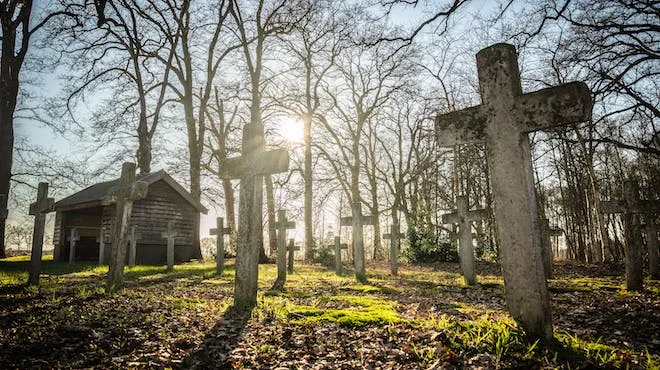
Welcome to our poem blog, where we explore the profound insights that literature has to offer. Today, we are ready to analyze Emily Dickinson’s poetry as we unpack the layers of her beautiful piece, “I Died for Beauty.”
In this discussion, we’ll go through the themes of mortality, truth, and beauty and the emotions conveyed. We will also do a full literature analysis of the poem, including the structure and form, rhyme scheme, poetic techniques, and a line-to-line analysis of each stanza.
The subject of “I Died for Beauty”
“I Died for Beauty” by Emily Dickinson is a contemplation of the human urge for truth and beauty. The poem features two individuals who, in life, pursued different ideals—one for beauty and the other for truth. In death, they find themselves lying side by side, united in their demise, regardless of their different aspirations.
Context of “I Died for Beauty”
The poem was written during a period marked by significant societal and cultural shifts. The mid-1800s was a period of interest in transcendentalism. Transcendentalism was a philosophical movement that emphasized the importance of intuition, nature, and individualism. Dickinson’s poetry often reflects these themes with a sprinkle of her own ideas on life, death, and the human condition.
Persona and Narrative of “I Died for Beauty”
The poem is written in first-person narration. So, the speaker is directly sharing personal reflections and engaging in dialogue with another individual who has also passed away.
Setting of “I Died for Beauty”
The setting of the poem is primarily symbolic, with the tomb serving as a metaphorical space. This setting transcends the physical world, allowing readers to reflect on the nature of life and mortality.
Themes and recurring ideas of “I Died for Beauty”
Mortality and Death
The poem revolves around the inevitability of death and the transient nature of human existence. Through the imagery of two individuals lying side by side in a tomb, Dickinson reflects on a universal experience.
Moreover, Dickinson emphasizes the equality of death as a shared fate for anyone and everyone, regardless of their worldly accomplishments or ideals.
Truth and Beauty
Throughout the poem, Dickinson juxtaposes the pursuit of truth with the pursuit of beauty. The fundamental idea suggests that both of these ideals are ultimately futile in the face of death. The poem raises questions about the nature of truth and beauty and their significance in human life.
Transcendence and Eternity
While the poem grapples with the finality of death, it also suggests the possibility of transcendence and eternity. The setting of the poem, being a conversation beyond death, gives a notion of an afterlife. Not surprisingly, this hints at Dickinson’s fascination with spiritual and metaphysical concepts.
The tone and mood of “I Died for Beauty”
The tone of “I Died for Beauty” by Emily Dickinson is contemplative and introspective. Moreover, it is evoking a reflection on the purpose of life and its meaning.
The mood of the poem is somber and meditative. As Dickinson stresses the inevitability of death, the fleeting nature of human existence is reflected. Overall, the tone and mood of the poem invite readers to ponder the mysteries of life and death.
The form and structure of “I Died for Beauty”
This is a concise poem consisting of four stanzas. Each stanza is composed of four lines, making the poem adhere to a quatrain structure. The length of the stanzas varies slightly, but they generally contain four short lines each.
In terms of punctuation, Dickinson’s style in this poem is characteristic of her broader body of work—sparse and unconventional. While there is some punctuation present, such as dashes and periods, Dickinson’s use of punctuation is minimal. Therefore, the flow of the poem is unhindered. In addition, the lack of strict punctuation encourages readers to pause and reflect on the meaning of each line.
The poem features a consistent rhyme scheme, with the second and fourth lines of each stanza rhyming. The rhyme scheme follows an ABAB pattern throughout the poem. Moreover, it adds a musical quality to the poem, contributing to its overall beauty and elegance.
Additionally, Dickinson employs internal rhyme and slant rhyme in some lines. Slant rhyme is a type of rhyme formed by words with similar but not identical sounds. This further enriches the poem’s auditory texture and adds complexity to its poetic form.
Line-by-line analysis of “I Died for Beauty”
“I died for beauty, but was scarce”
This opening line immediately introduces the central theme of mortality and sets the tone of the poem.
The phrase “I died for beauty” suggests that the speaker sacrificed her life in devotion to beauty. It indicates a deep commitment and passion for aesthetic ideals connected with beauty. However, the word “scarce” introduces a sense of limitation or inadequacy, implying that her attempts were in vain. In addition, it infers that despite her dedication to beauty, her life was cut short.
Here, Dickinson employs personification, where the act of dying is attributed to a concept like beauty. Additionally, the line also features enjambment, as it flows seamlessly into the next line without pause.
“Adjusted in the tomb,”
In the second line, Dickinson employs imagery to evoke the image of the speaker lying in a tomb. The word “adjusted” suggests a sense of fitting or arrangement, implying that the speaker has just been laid to rest. It also implies a sense of acceptance.
Furthermore, this image serves as a stark reminder of the finality of death and the confinement of the grave. The shortness of this line adds to its impact. Additionally, it emphasizes the abruptness of death and the simplicity of the speaker’s final resting place.

“When one who died for truth was lain”
In this line, Dickinson introduces a second figure who has also passed away, this time for the pursuit of truth. This immediately creates the imagery of two coffins placed parallelly in a graveyard.
This line connects with the previous lines, where the speaker proclaimed their dedication to beauty. Here, Dickinson juxtaposes the pursuit of truth with the pursuit of beauty, suggesting that both ideals hold significance.
Additionally, Dickinson employs metonymy, using “truth” to represent the pursuit of knowledge and enlightenment.
“In an adjoining room.”
Here, Dickinson creates a sense of spatial separation between the speaker and the other individual. The use of the word “adjoining” implies proximity or closeness. However, it also hints that, despite their different paths, they ultimately ended up in close proximity, separated just by a fine boundary.
The phrase “adjoining room” could also serve as a simplified metaphor for the afterlife or the realm beyond death.
“He questioned softly why I failed?”
In this line, Dickinson introduces dialogue between the speaker and the other individual who pursued truth. The use of dialogue adds depth to the poem, allowing for a direct exchange of ideas and perspectives.
The word “questioned” suggests a gentle inquiry, indicating the other individual’s curiosity about the speaker’s motives for pursuing beauty. Dickinson employs understatement here, as the question carries significant weight and prompts the speaker to reflect on their own choices and beliefs.
“For beauty,” I replied.”
The speaker’s sharp and direct response also underscores the true commitment he had to the pursuit of beauty. The use of the first-person pronoun “I” allows the readers to connect more deeply with the conversation. Additionally, the short answer could hinder a sense of regret or thoughtfulness.
“And I for truth – the two are one;”
Here, the other individual responds that he died for the truth. This response is not an answer to a question but rather a self-statement to maintain the flow of the conversation. It hints that this other individual is trying to create a conversation. Furthermore, this statement has a sense of acceptance and hints that the other individual is more aware of the situation.
The phrase “the two are one” infers the connected nature of truth and beauty. Here, the poem’s central paradox is introduced, which is the ultimate unity of truth and beauty. Furthermore, it suggests that the pursuit of one inevitably leads to the other.
Dickinson employs this antithesis to juxtapose the seemingly opposing ideals of truth and beauty, highlighting their underlying harmony and mutual dependence.
This idea that “the two are one” suggests a profound philosophical insight, challenging conventional notions of dichotomy and duality.
“We brethren are,” he said.”
The other individual concludes the dialogue by introducing the kinship between them. The use of the word “brethren” conveys a sense of camaraderie and shared experience, emphasizing the commonality.
Dickinson employs synecdoche here, using “brethren” to represent the broader human experience and the universal quest for meaning and enlightenment.
“And so, as kinsmen met a-night,”
In the final stanza, Dickinson returns to the metaphor of kinship. This simile evokes a sense of familial closeness and intimacy, suggesting a deep bond between the two individuals who have passed away. The speaker compares this meeting in the face of death to a nighttime gathering between two very close brothers. Here, Dickinson creates a sense of warmth and comfort, implying a mutual understanding between the two figures.
The use of the phrase “a-night”, being singular, adds a sense of impermanence. This hints at the deeper aspects of time after the eternal recurrence of human existence. Additionally, the use of enjambment here connects this line to the following one, creating a seamless transition between stanzas and reinforcing the poem’s rhythmic structure.
“We talked between the rooms,”
In the concluding line, Dickinson employs imagery to depict the ongoing dialogue between the speaker and the other individual beyond the confines of death. The phrase “between the rooms” suggests a liminal space—neither fully within nor outside the realm of the living—where the two figures continue their conversation.
The use of enjambment and the repetition of the word “rooms” from earlier in the poem create a sense of circularity, emphasizing the cyclical nature of existence. Moreover, this mysterious element of rooms and corridors creates a link with the passages and rooms described in near-death experiences and dreams. Again, this transcendance foreshadows Dickson’s fascination with these concepts of life after death.

“Until the moss had reached our lips,”
The imagery of moss reaching their lips adds a haunting final touch to the poem. Moss is a common symbol of decay and symbolizes the passage of time. Interestingly, this suggests that even in death, the speaker and the other individual are not immune to the ravages of nature.
This image serves as a reminder of the impermanence of human existence and the inevitability of mortality. The use of personification—attributing a power to the moss—heightens the sense of inevitability and finality, as if nature itself is reclaiming the speakers into its embrace.
Furthermore, the final idea is that the two individuals, now brothers, continued their conversation for a very long time. This brings us back to the poem’s central message about how truth and beauty intertwine in the face of death.
“And covered up our names.”
The final line of the poem brings a sense of closure and finality to the speaker’s tale. This image not only symbolizes the passage of time but also the erasure of individual identity in death. By emphasizing the anonymity of truth and beauty after death, Dickinson underscores the universal nature of the human experience in the face of mortality.
The brevity and simplicity of the line add to its impact, serving as a conclusion to the poem’s exploration of truth, beauty, and the enduring legacy of human connection.
The moral of “I Died for Beauty”
The moral of Emily Dickinson’s poem “I Died for Beauty” serves as an acknowledgment of the universal nature of death and the futility of human pursuits of beauty and truth.
Furthermore, the moral may lie in recognizing the interconnectedness of human experiences and the importance of finding meaning and connection in the midst of life’s uncertainties. Additionally, the poem prompts reflection on the transient nature of worldly pursuits and the value of embracing the inherent beauty and truth found in the human condition.
What could be the influences on “I Died for Beauty”?
Transcendentalist Ideals: Transcendentalist philosophy deeply influenced Dickson. Other transcendentalist thinkers during this time, such as Ralph Waldo Emerson and Henry David Thoreau, explored these themes of spiritual truth. Thus, it is possible that these may have inspired Dickinson to create this piece.
Personal Reflections on Mortality: Throughout her life, Dickinson grappled with the concept of death and the mysteries surrounding it. As she experienced the loss of loved ones and confronted her own mortality, Dickinson’s poetry often turned to themes of death and the afterlife. Therefore, “I Died for Beauty” reflects Dickinson’s musings on the inevitability of death and the human quest for meaning in the face of mortality.
Cultural and Social Context: The mid-19th century was a period of significant societal and cultural change in America. The rise of industrialization and urbanization, coupled with political and religious upheaval, prompted many writers and thinkers to question traditional beliefs and values.
Literary Influences: Dickinson was an avid reader and drew inspiration from a wide range of literary sources, including the Bible, Shakespeare, and contemporary poets. The themes and motifs found in “I Died for Beauty” resonate with other works of Romantic and transcendentalist literature, suggesting that Dickinson may have been influenced by the writings of her literary predecessors.
About the author, Emily Dickinson
Emily Dickinson (1830–1886) remains one of the most celebrated poets in American literary history. Born in Amherst, Massachusetts, Dickinson spent much of her life in relative seclusion, choosing to withdraw from society. Nevertheless, Dickinson possessed a keen intellect and a profound sensitivity to the world around her, which she expressed through her poetry.
Dickinson’s poetic career began during her late teens and early twenties. She continued to write throughout her life, composing nearly 1,800 poems, though fewer than a dozen were published during her lifetime. Her poems are characterized by their shortness, unconventional punctuation, and elliptical style, often conveying complex themes and emotions in simple language.
Dickinson’s poetry explores a wide range of subjects, including nature, love, death, spirituality, and the human psyche. She drew inspiration from authors like Ralph Waldo Emerson and Henry David Thoreau, as well as the Romantic and transcendentalist movements of her time. However, Dickinson’s voice is distinctly her own, marked by her unique perspective on the world and her willingness to grapple with life’s most profound questions.
Despite the mysteries that surround her, Dickinson’s words continue to resonate with readers around the world, offering solace, inspiration, and profound reflections on the complexities of existence.
Read other Emily Dickson’s poems analyzed by us. Visit Tell all the truth but tell it slant: An Analysis – PoemRead
Conclusion
“I Died for Beauty” by Emily Dickinson is a reflective poem that explores themes of mortality, truth, and beauty. The narrator shares a dialogue with another individual who has also passed away, discussing their reasons for dying. Through the conversation, the poem conveys a sense of introspection and contemplation, with emotions of solemnity and acceptance prevailing.
Dickinson’s intention may have been to provoke thought and reflection on the nature of existence and the pursuit of truth and beauty. The poem’s target audience could be anyone grappling with existential questions or seeking deeper meaning in life. It is written from the poet’s perspective, offering a glimpse into Dickinson’s own philosophical musings. Reading the poem may evoke a sense of introspection and contemplation, prompting readers to ponder their own beliefs and values in relation to life and death.
RELATED POSTS
View all



